The city of Fort Worth has almost three hundred parks. Most of those parks have nonpersonal names: Trinity, Forest, Gateway, Sycamore.
But some of our parks are named for people in Fort Worth history:
 A monument (1893) to Al Hayne stands in a small park at the intersection of Main Street and Lancaster Avenue. When the Texas Spring Palace, located just south of the park, burned in 1890 Hayne was one of the heroes and the only fatality. The park originally was a triangle formed by Houston, Main, and Lancaster streets. When three streets intersect with an acute angle, the resulting triangle often is too small to be of commercial value. So, it becomes a city park. The Houston Street side of the Al Hayne triangle was eliminated in 2008.
A monument (1893) to Al Hayne stands in a small park at the intersection of Main Street and Lancaster Avenue. When the Texas Spring Palace, located just south of the park, burned in 1890 Hayne was one of the heroes and the only fatality. The park originally was a triangle formed by Houston, Main, and Lancaster streets. When three streets intersect with an acute angle, the resulting triangle often is too small to be of commercial value. So, it becomes a city park. The Houston Street side of the Al Hayne triangle was eliminated in 2008.
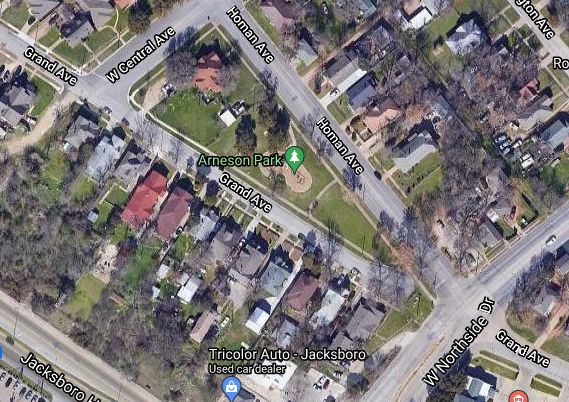 Arneson Park on the North Side is another triangular park.
Arneson Park on the North Side is another triangular park.
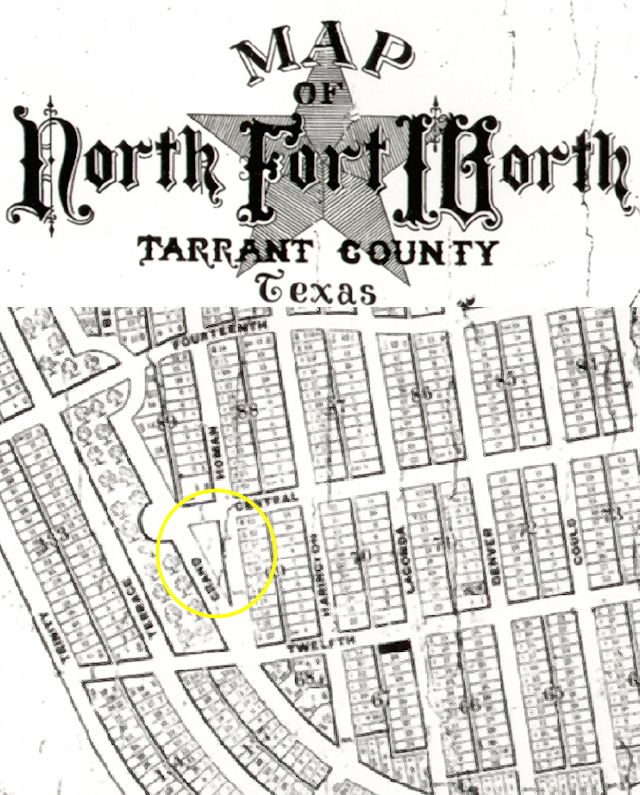 Nathan Barrett’s 1888 plat of the city of North Fort Worth created a small triangle between Grand, Central, and Homan avenues.
Nathan Barrett’s 1888 plat of the city of North Fort Worth created a small triangle between Grand, Central, and Homan avenues.
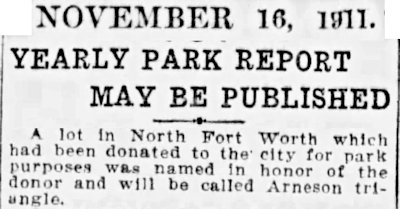 In 1911 the park board named the park for its donor, real estate dealer Axel Arneson.
In 1911 the park board named the park for its donor, real estate dealer Axel Arneson.
 In 1910 the city bought from Charles Nash land at the corner of Cold Springs Road and Samuels Avenue. Madam Frankie Brown’s brothel and later an orphanage had once stood on the site. The land was developed as a small park named for Major Ripley Allen Arnold.
In 1910 the city bought from Charles Nash land at the corner of Cold Springs Road and Samuels Avenue. Madam Frankie Brown’s brothel and later an orphanage had once stood on the site. The land was developed as a small park named for Major Ripley Allen Arnold.
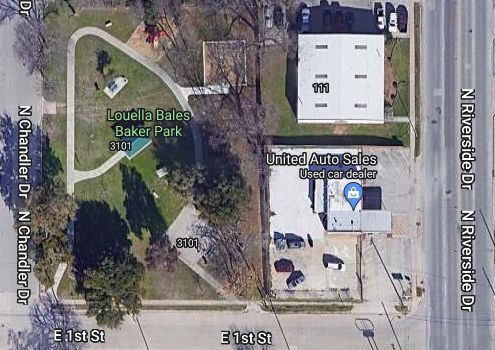
If the trees in little Louella Bales Baker Park on East 1st Street in Riverside seem especially varied, that’s because the park stands on the site of Fort Worth’s first nursery.
James Beauland Baker was born in England in 1863. In 1870 he and his brother William moved to Texas with their father, a dairyman and preacher.
In 1884 James and brother William moved to Fort Worth, where with Robert Drumm they bought forty-six acres in the sparsely settled Sylvania (Riverside) area. The three men opened Fort Worth’s first nursery. Fort Worth Nursery specialized in fruit and shade trees.

The brothers and Drumm dissolved their partnership in 1889, although the Drumm nursery and the Baker brothers nursery continued to operate side by side.
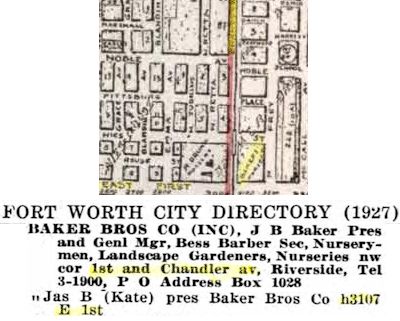
In 1900 James Baker married Kate Bales of a pioneer Fort Worth family. For the Bakers, money grew on trees. James and Kate prospered. In 1927 James and Kate built a four-thousand-square-foot home on the nursery property, by then located on East 1st Street at Chandler Drive. The 1925 map shows Drumm Seed and Floral across Chandler Drive from the Baker nursery. The Baker nursery encompassed a city block, with rows of hothouses located north of the Baker home. (Before Riverside Drive was built, Chandler Drive was a major street in Riverside, complete with streetcar service.)
James Baker died in 1946. Kate Bales Baker died in their home in 1969. The nursery that the Baker brothers began in 1884 closed in its centennial year.
In 1993 Fort Worth philanthropist Louella Baker Martin, the granddaughter of James and Kate, donated the house to Texas Wesleyan University and paid to have the house moved to the TWU campus and restored. The house was moved in two parts. The second floor was suspended on stands while the first floor was moved to its new location. Then the second floor was moved and reunited with its first floor.
In 1998 Louella Baker Martin and her husband, Nicholas Martin (a former part-owner of the Texas Rangers), donated part of the Baker nursery property on East 1st Street to the city for use as a park named for Mrs. Martin’s mother, Louella Bales Baker. (Thanks to Paul Valentine for the tip.)
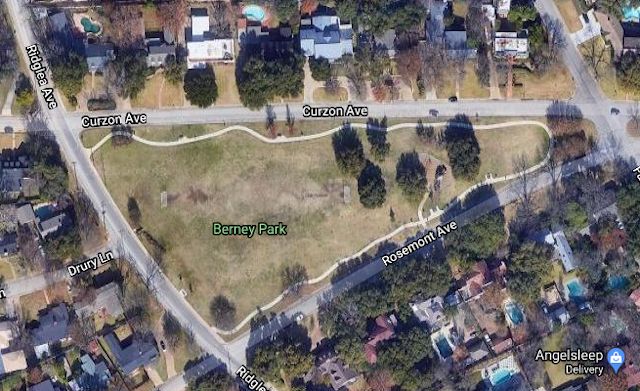 Morris Berney was a cotton dealer and real estate developer. He was the son-in-law of cotton broker Neil P. Anderson. Berney also was a developer of Ridglea addition in west Fort Worth and the golf course that became Ridglea Country Club. Berney also was a longtime member of the park board.
Morris Berney was a cotton dealer and real estate developer. He was the son-in-law of cotton broker Neil P. Anderson. Berney also was a developer of Ridglea addition in west Fort Worth and the golf course that became Ridglea Country Club. Berney also was a longtime member of the park board.
When Ridglea addition was developed, triangular Ridglea Park was created.
 Ridglea Park was small but big enough to host free movies sponsored by Leonard’s Department Store. Leonard’s sponsored free movies in city parks from 1943 to 1953.
Ridglea Park was small but big enough to host free movies sponsored by Leonard’s Department Store. Leonard’s sponsored free movies in city parks from 1943 to 1953.
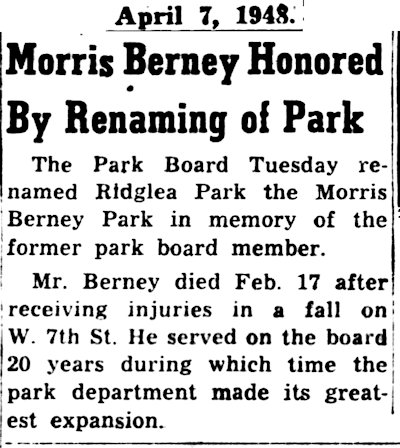 After Berney died in 1948 the park board renamed the park “Morris Berney Park.”
After Berney died in 1948 the park board renamed the park “Morris Berney Park.”
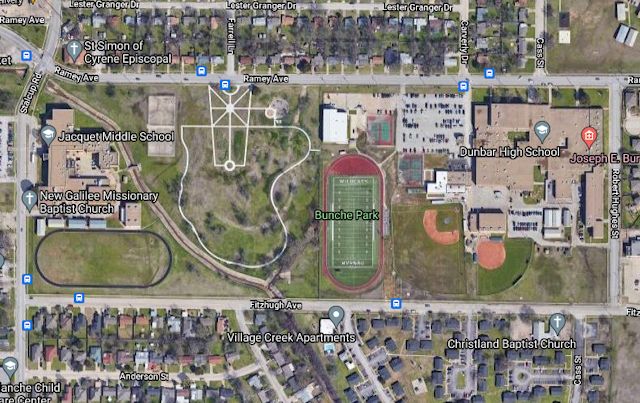
 Ralph Bunche Park on Ramey Avenue on the East Side is named for the civil rights leader and 1950 Nobel Peace Prize winner.
Ralph Bunche Park on Ramey Avenue on the East Side is named for the civil rights leader and 1950 Nobel Peace Prize winner.
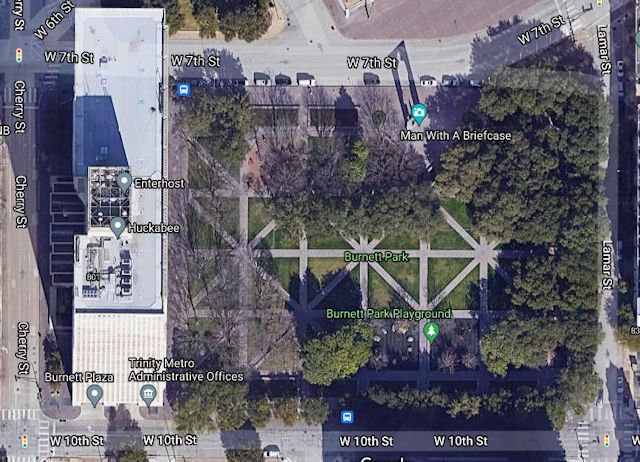
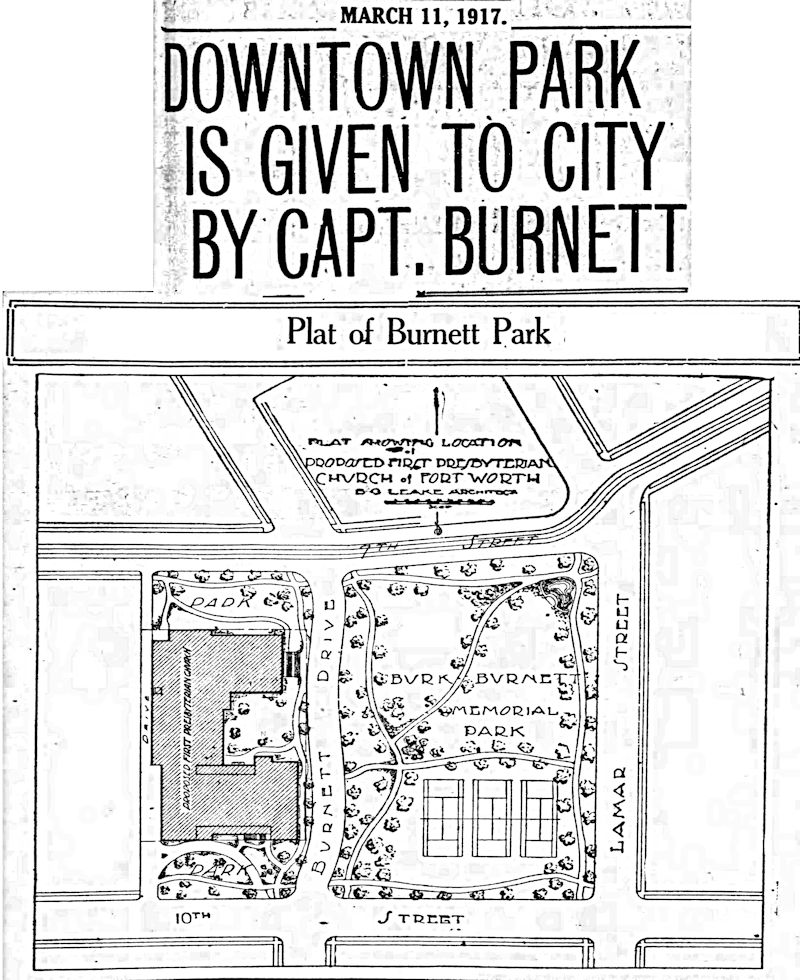 In 1917 cattleman and capitalist Samuel Burk Burnett donated a city block for a park “to perpetuate the memory of my two children, Anne and Burk, now long gone from me.”
In 1917 cattleman and capitalist Samuel Burk Burnett donated a city block for a park “to perpetuate the memory of my two children, Anne and Burk, now long gone from me.”
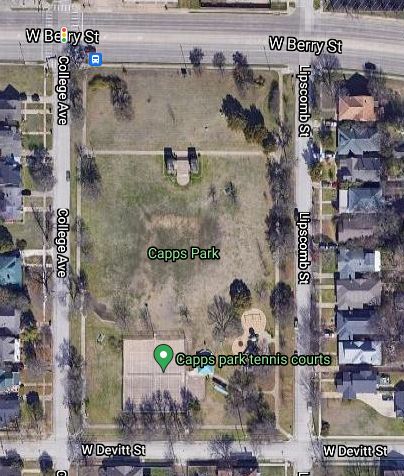
 As an attorney William Capps played a minor role in the sagas of Jim Courtright and Dr. Henry Howard Holmes. Capps also was a real estate developer. In 1909 he donated a city block on West Berry Street for a park.
As an attorney William Capps played a minor role in the sagas of Jim Courtright and Dr. Henry Howard Holmes. Capps also was a real estate developer. In 1909 he donated a city block on West Berry Street for a park.
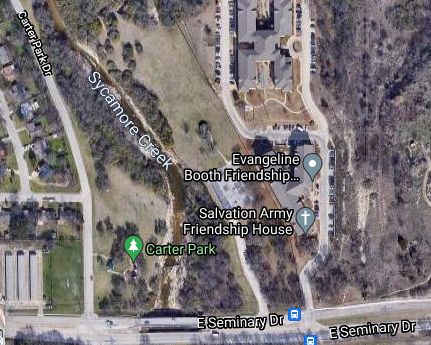 Fort Worth is the town of Carter This and Carter That. And understandably so. No one did more for Fort Worth during the twentieth century than did Amon Carter. So, it’s not surprising that we have a Carter Park on Sycamore Creek in southeast Fort Worth. And nearby a Carter housing addition and a Carter elementary school.
Fort Worth is the town of Carter This and Carter That. And understandably so. No one did more for Fort Worth during the twentieth century than did Amon Carter. So, it’s not surprising that we have a Carter Park on Sycamore Creek in southeast Fort Worth. And nearby a Carter housing addition and a Carter elementary school.
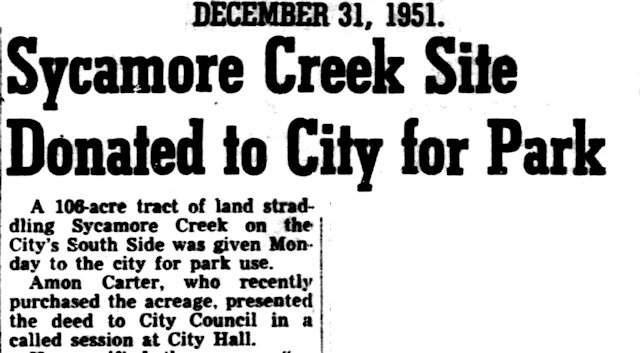 In 1951 Carter donated 106 acres to the city for use as a park.
In 1951 Carter donated 106 acres to the city for use as a park.
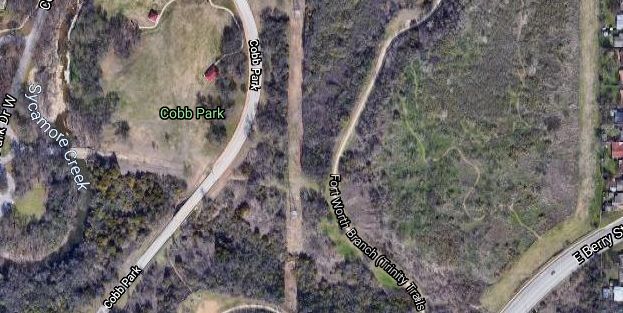 Cobb Park was named for Horace H. Cobb.
Cobb Park was named for Horace H. Cobb.
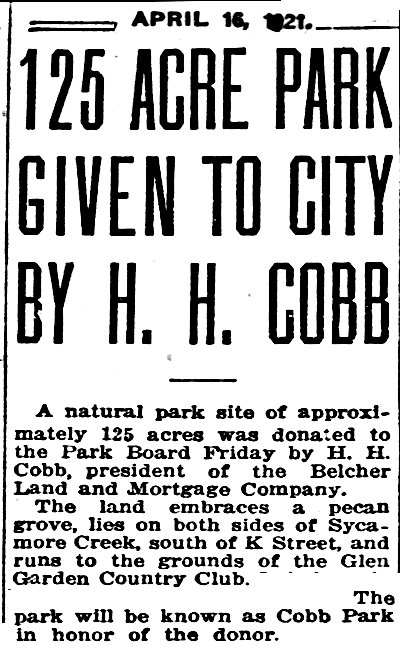 In 1921 Cobb donated 125 acres adjacent to the Cobb brothers’ brick plant on Sycamore Creek. The brothers also owned a cattle ranch nearby. Glen Garden Country Club was built on Cobb land.
In 1921 Cobb donated 125 acres adjacent to the Cobb brothers’ brick plant on Sycamore Creek. The brothers also owned a cattle ranch nearby. Glen Garden Country Club was built on Cobb land.
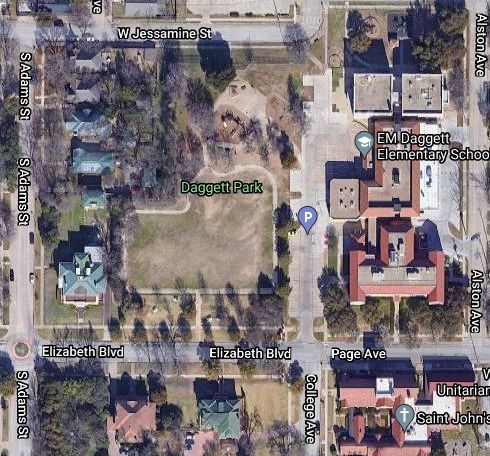 Daggett Park just north of Elizabeth Boulevard is named for early civic leader Ephraim Merrell Daggett. Three nearby schools also are named for Daggett.
Daggett Park just north of Elizabeth Boulevard is named for early civic leader Ephraim Merrell Daggett. Three nearby schools also are named for Daggett.
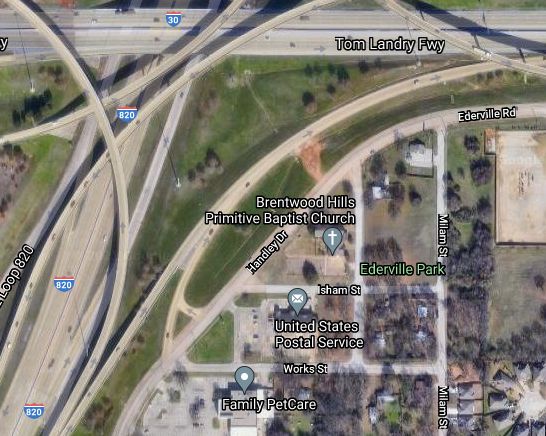 Ederville Park is named for the former community named for George Eder. The park is located where Ederville once stood—just southeast of the intersection of Interstate 30 and East Loop 820.
Ederville Park is named for the former community named for George Eder. The park is located where Ederville once stood—just southeast of the intersection of Interstate 30 and East Loop 820.
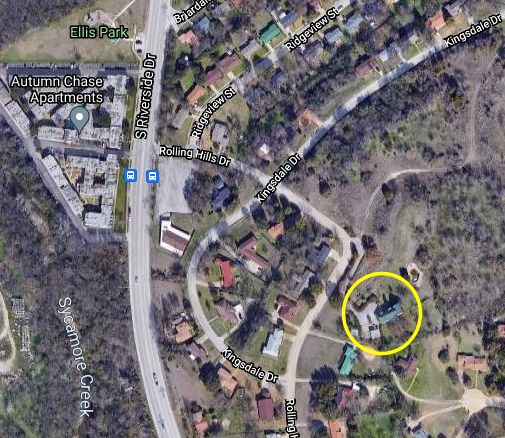 Ellis Park on Riverside Drive in southeast Fort Worth is located on land once owned by the Ellis family. Three generations of Ellises were real estate developers who owned acres of land in the area. The circle shows the home built by third-generation J. Merida Ellis.
Ellis Park on Riverside Drive in southeast Fort Worth is located on land once owned by the Ellis family. Three generations of Ellises were real estate developers who owned acres of land in the area. The circle shows the home built by third-generation J. Merida Ellis.
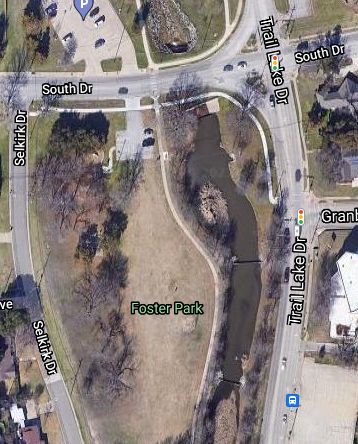
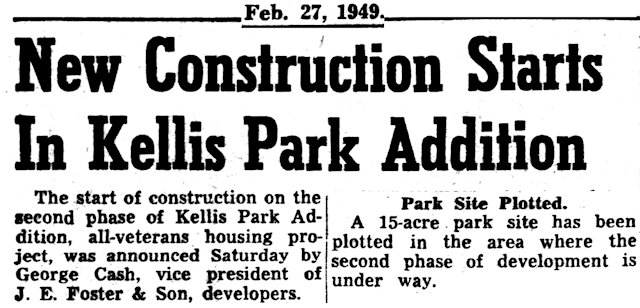 When J. E. Foster & Son began development of the second phase of Kellis Park addition in southwest Fort Worth, the company gave the city fifteen acres along a creek for use as a city park. (Foster also developed Westcliff Shopping Center and the Westcliff addition.)
When J. E. Foster & Son began development of the second phase of Kellis Park addition in southwest Fort Worth, the company gave the city fifteen acres along a creek for use as a city park. (Foster also developed Westcliff Shopping Center and the Westcliff addition.)
George Cash of J. E. Foster & Son said the Kellis Park addition was the nation’s first all-veterans housing project, developed in coordination with the Veterans Administration.
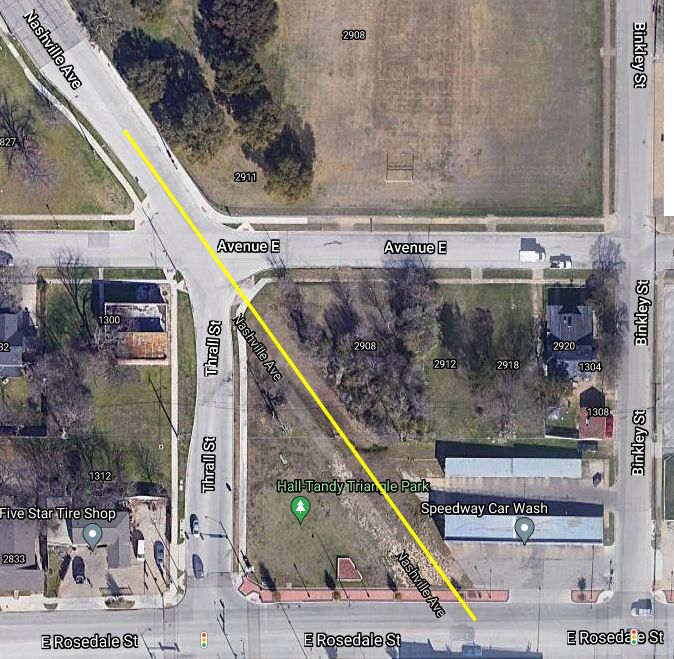 In 1855 Kentuckians Roger Tandy (1806-1898) and his brother-in-law, Arch Hall (1831-1927), settled on land grants (probably Peters Colony) in what would become the community of Polytechnic. Roger impounded Tandy Lake. Roger’s son George was an early civic leader in Poly.
In 1855 Kentuckians Roger Tandy (1806-1898) and his brother-in-law, Arch Hall (1831-1927), settled on land grants (probably Peters Colony) in what would become the community of Polytechnic. Roger impounded Tandy Lake. Roger’s son George was an early civic leader in Poly.
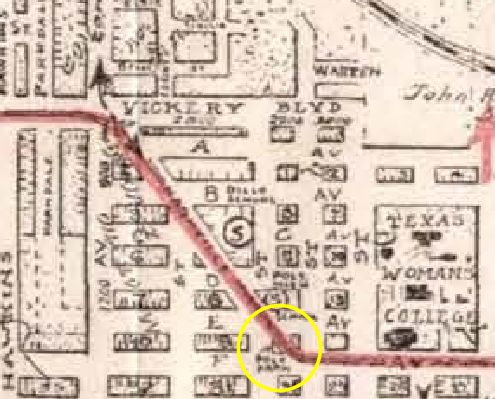 Northern Texas Traction Company’s interurban track ran along Nashville Avenue and Rosedale Street in Poly. Nashville Avenue at the time extended to Rosedale Street, and Nashville, Rosedale, and Thrall streets formed a triangle. In 1922 NTTC donated that triangle to the city for use as a park.
Northern Texas Traction Company’s interurban track ran along Nashville Avenue and Rosedale Street in Poly. Nashville Avenue at the time extended to Rosedale Street, and Nashville, Rosedale, and Thrall streets formed a triangle. In 1922 NTTC donated that triangle to the city for use as a park.
The park, originally known as “Polytechnic Park,” was renamed “Hall Tandy Memorial Park” in 1985.
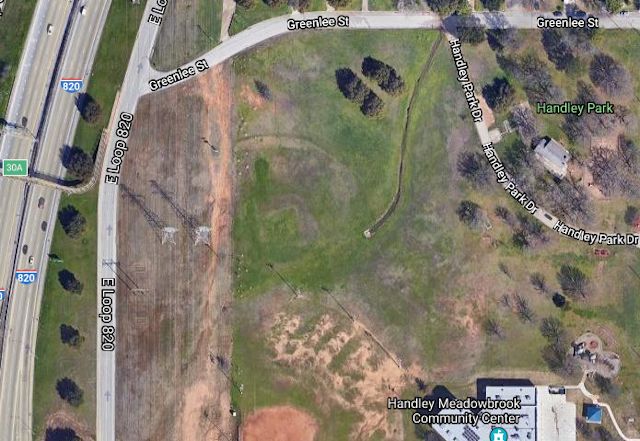 Handley Park east of East Loop 820, like the former town of Handley, is named for Confederate Major James Madison Handley, who owned a plantation in the area. He died in 1908.
Handley Park east of East Loop 820, like the former town of Handley, is named for Confederate Major James Madison Handley, who owned a plantation in the area. He died in 1908.
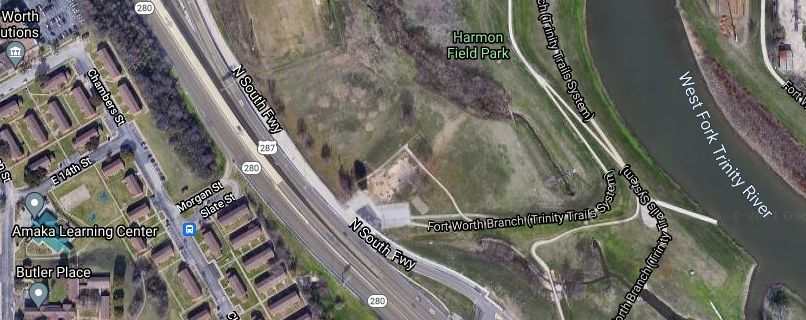 Harmon Field Park is located between the Trinity River and Martin Luther King Jr. Freeway.
Harmon Field Park is located between the Trinity River and Martin Luther King Jr. Freeway.

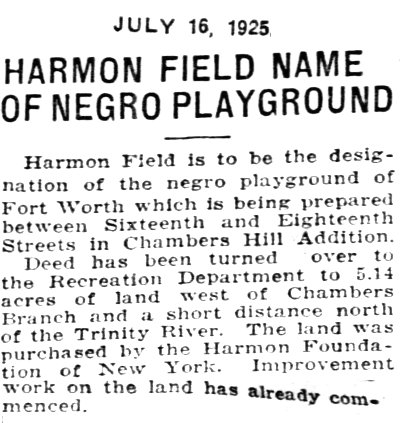 In 1925 the park was named for philanthropist William E. Harmon of New York City, whose foundation had donated the land for use as a park for African Americans.
In 1925 the park was named for philanthropist William E. Harmon of New York City, whose foundation had donated the land for use as a park for African Americans.
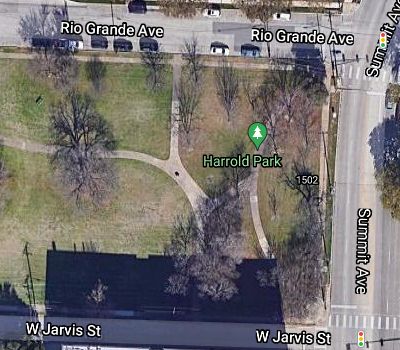
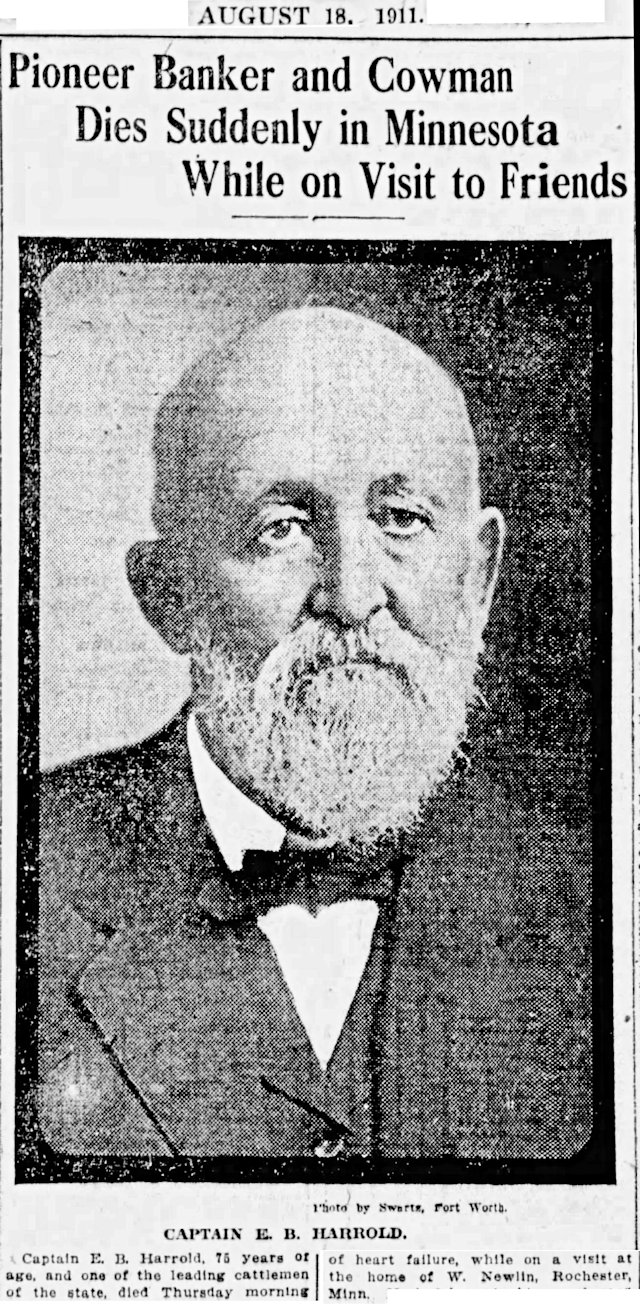 Harrold Park on Summit Avenue was named for Ephraim B. Harrold (1835-1911). Harrold was an officer of First National Bank and partner in real estate with Winfield Scott and in cattle with Scott and Burk Burnett. In 1895 Harrold and Scott built the Harrold Building, which became the home of The Fair department store.
Harrold Park on Summit Avenue was named for Ephraim B. Harrold (1835-1911). Harrold was an officer of First National Bank and partner in real estate with Winfield Scott and in cattle with Scott and Burk Burnett. In 1895 Harrold and Scott built the Harrold Building, which became the home of The Fair department store.
The town of Harrold in Wilbarger County was named for him. His Bar-X Ranch was located there.
Harrold’s mansion at 1502 Summit was typical of Quality Hill mansions: eighteen rooms, a stable/carriage house, guest house, greenhouse, and servants quarters on an oversized lot.
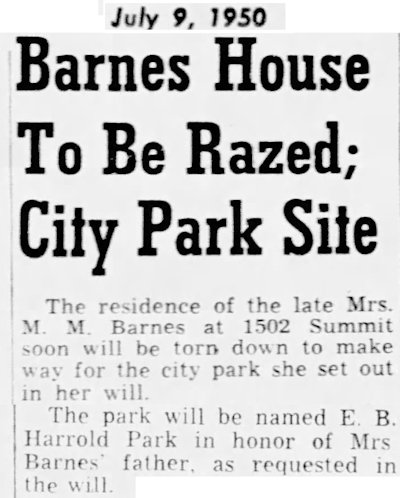 After Harrold died, his daughter Josephine continued to live in the house. She died in 1947. Her will left the property to the city to develop as a park. In 1950 the house was demolished.
After Harrold died, his daughter Josephine continued to live in the house. She died in 1947. Her will left the property to the city to develop as a park. In 1950 the house was demolished.
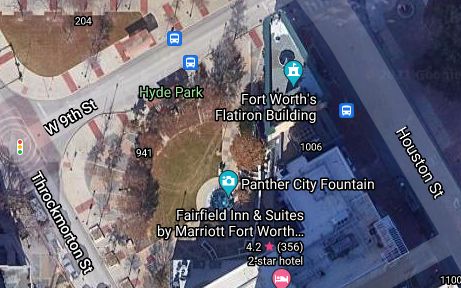 Downtown’s little Hyde Park is said to be Fort Worth’s first city park, the land given to the city about 1873 by Mrs. Sarah Jennings. The park is named for her parents, Mr. and Mrs. John Hansford Hyde. In 2002 a fountain with a sculpture of a sleeping panther was added to the park.
Downtown’s little Hyde Park is said to be Fort Worth’s first city park, the land given to the city about 1873 by Mrs. Sarah Jennings. The park is named for her parents, Mr. and Mrs. John Hansford Hyde. In 2002 a fountain with a sculpture of a sleeping panther was added to the park.
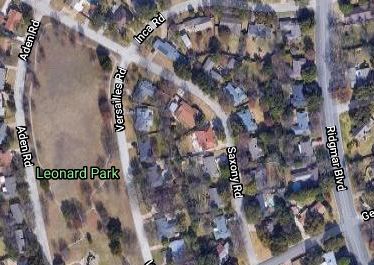 Leonard Park in Ridgmar honors Marvin Leonard and wife Mary. In addition to operating the department store, Marvin Leonard developed golf courses and real estate, including Ridgmar.
Leonard Park in Ridgmar honors Marvin Leonard and wife Mary. In addition to operating the department store, Marvin Leonard developed golf courses and real estate, including Ridgmar.
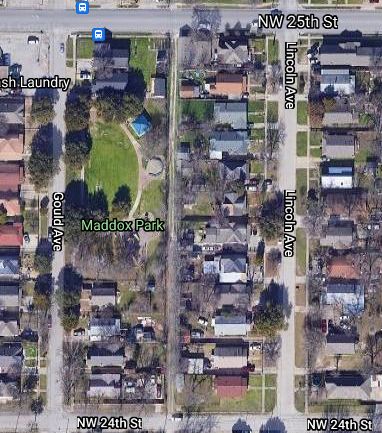

 Maddox Park on the North Side was named for James Hodge Maddox of the ubiquitous Maddox family. James, who once worked for Jim Courtright’s T.I.C. detective agency, was later police chief, fire chief, a city commissioner, and first chairman of the park board in 1909.
Maddox Park on the North Side was named for James Hodge Maddox of the ubiquitous Maddox family. James, who once worked for Jim Courtright’s T.I.C. detective agency, was later police chief, fire chief, a city commissioner, and first chairman of the park board in 1909.
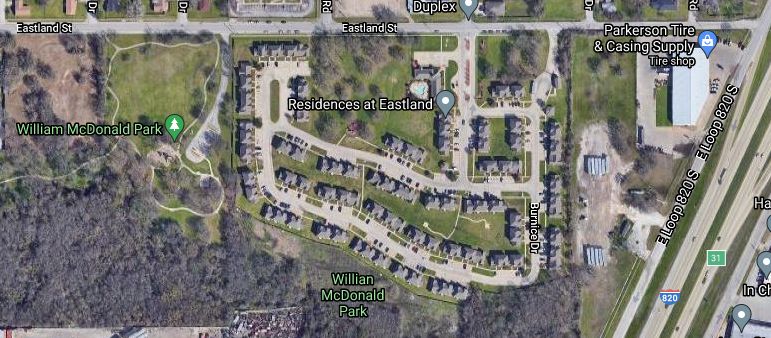 McDonald Park on the East Side was named for William Madison (“Gooseneck Bill”) McDonald, who was an early business and fraternal leader in Fort Worth’s African-American community.
McDonald Park on the East Side was named for William Madison (“Gooseneck Bill”) McDonald, who was an early business and fraternal leader in Fort Worth’s African-American community.
Park Names From A to Z (Al Hayne to Z. Boaz) (Part 2)





